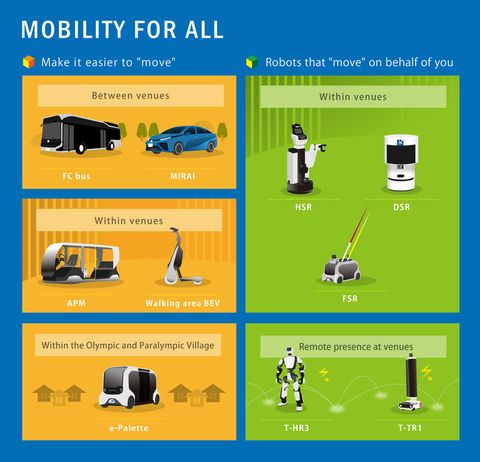- Toyota is planning to introduce new products that are not cars, trucks, or SUVs with the message that Toyota is becoming a “mobility company.”
- Toyota will continue to build and sell conventional vehicles, but is developing a range of products for people currently underserved by conventional transportation and personal mobility solutions.
- The company will showcase one of those potential future products, an autonomous vanlike transportation module called the e-Palette (below), at the 2020 Tokyo Summer Olympics and Paralympics.
If those oddly shaped autonomous vehicles above look weird to you, you’d better stand back, because Toyota is thinking in a lot of new directions. “Mobility for all―bringing the joy and freedom of movement to all people―is the goal we work toward,” says Toyota on its website. The company goes on to state that it aims to create innovations in next-generation mobility featuring cutting-edge technologies with the potential for “expanding the possibilities of future mobility.”
Is this just fancy corporate-speak? Not according to top Toyota executives. “I think of us as the Human Movement Company,” says Jack Hollis, group vice president and general manager of the Toyota division of Toyota Motor North America. “We’re looking out globally,” Hollis says, in considering the needs of the world’s diverse population. “In this country we think of mobility as cars, but mobility is different for different people around the world.”
Hollis won’t say what products the company will be announcing in the next several years, but he alludes to the fact that it could be just about anything that helps people get around better. “For people in some countries, it could be a single-seat transporter like our iRoad,” a cool-looking, experimental, three-wheel electric vehicle made for low-speed inner-city travel that leans into turns like a bicycle.
“In some places it could be an electric skateboard—or even shoes!” Hollis laughs and waves away the idea that Toyota will be getting into footwear. “But what about giving an elderly person a better way to get around when you have to take their car keys away? It could be a robo-taxi.”
Or something else entirely; Toyota has research initiatives into dozens of related fields. Its robotics group not only has created the amazing T-HR3 Humanoid robot, which could, theoretically, do your housework. But it has used that technology to build robotic people helpers like the Human Support robot; it looks like C-3PO’s little brother, and it can provide bedside nursing support for the sick or elderly. The company has also shown the exoskeleton-like WelWalk rehabilitation device, which assists patients recovering from leg paralysis. Walking is, after all, the most basic form of mobility.
Toyota’s corporate vision of mobility also encompasses helping people get places with less stress, cost, and wasted time. Toyota’s Ha:Mo project—Ha:Mo stands for “Harmonious Mobility Network”—aims to integrate shared vehicle use and public transportation to make mobility in congested cities quicker, more convenient, and more efficient. And of course, Toyota is working on all of the same autonomous, connected-car, and electric-vehicle initiatives as every other auto manufacturer.
“When people are mobile, their lives are better, they’re happier,” says Hollis. Toyota chairman Akio Toyoda, Hollis says, “told me that his KPI—his key performance indicator—was smiles. I said, ‘Really?’ He said, ‘Yes!’ “
Toyota will showcase one of its mobility-product experiments, the e-Palette, by providing a fleet of the autonomous, vanlike people movers to the 2020 Tokyo Summer Olympics and Paralympics games. The driverless vehicles will be available to transport the athletes to and from their events.


